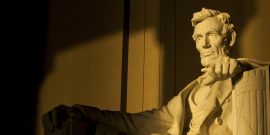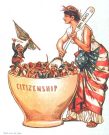One the ways Americans can unite is over our shared purposes, but for this to work, we need a renewed attention to the story of American liberty.
The Moral Foundation of American Constitutionalism
Very few contemporary legal thinkers turn to natural law for help in interpreting the Constitution. Among the many reasons for this, one is the belief that natural law supports slavery. Justin Dyer takes on this belief and attempts to rehabilitate natural law thinking by introducing us to a natural law constitutional tradition that vigorously opposed slavery. Moreover, while examining that tradition, he argues that natural law is an essential presupposition of English and American constitutionalism altogether. Dyer’s title may have an academic ring to it, but his book aims high, since its goal is to recover the moral foundation of Anglo-American constitutionalism.
By “natural law” Dyer has in mind not the opinions of philosophers, but those of judges and statesmen. It is what Thomas Jefferson called the “American mind” – a set of ideas that (in Jefferson’s words) rested on “the harmonizing sentiments of the day” (p. 1). The core of these ideas are the natural rights expressed in the Declaration of Independence, understood as resting on the premise that reason can discover in human nature, general, morally obligatory principles of action (or justice) that are ultimately traceable to God, the creator and orderer of nature.
That the US Constitution rests on a moral foundation of natural law is a controversial claim. The idea was rejected years ago by Oliver Wendell Holmes when he argued that law is founded on “arbitrary desires, beliefs, and wishes of society” rather than on any pre-existing rational order (25). More recently, scholars have argued that there were “multiple traditions” at the founding period and that there is no good reason to single out any particular one of them (e.g., Jefferson’s) as correct: there is no authoritative guide, only a multiplicity of conflicting positions, some of which are proslavery, some antislavery. Still another view, ultimately traced to Thomas Hobbes, maintains that the purpose of constitutionalism is to secure peace rather than justice. These approaches differ greatly from one another, Dyer argues, but they share two assumptions: that there is no discernible moral order, and that the Constitution if not predominantly proslavery, is at best neutral with regard to the contrary aspirations of proslavery and antislavery constitutionalists.
Against these views, Dyer appeals to Abraham Lincoln’s description of the Constitution as an apple of gold in a picture of silver. Lincoln regarded the Constitution (and the Union and government established by it) as fundamentally an instrument (the silver frame) whose purpose is to adorn and preserve an aspiration towards the golden apple of human equality and freedom. Despite the Constitution’s compromises with slavery, therefore, Lincoln could admire and support it because he believed that it put slavery on the path to eventual extinction. Dyer’s book is a defense of Lincoln’s view and is in many ways an excavation of its premises and precursors.
The basic difficulty is easily stated. If all men are created equal, so that government rests on the consent of the governed and is limited by inalienable natural rights, and if these principles underlie the government established in the Constitution, then the institution of race-based chattel slavery is a gross contradiction of the founding principles of American government. Worse even than this contradiction between principle and fact are the “disharmonies” in the Constitution itself. While it is the foundation of American liberties, the Constitution also has many provisions that appear to protect slavery: the notorious three fifths clause and interstate rendition of fugitive slaves, to mention only two examples. Far from being the glorious “liberty document” Lincoln thought it was, the Constitution seems at best ambiguous on the question of slavery and at worst directly to support it.
How then did men with antislavery sentiments work within the constitutional order to promote their views? The heart of Dyer’s answer is sketched in chapters two through five, which reflect on a series of court cases that occurred between 1772 and 1857. It is a complex, even convoluted story, in part because there is no simple linear progress, but also because each case involves different parts of the law, different legal and political circumstances, and different aspects of the contradictions mentioned above. With the occasional detour to visit a scholarly controversy, Dyer guides the reader through these multiple complex considerations with an eye for the essential fact and the heart of an argument. No one is likely to be satisfied with every argument, but he raises many essential questions and I know of no more succinct introduction to the issue.
In the first case discussed, the English case of Somerset v. Stewart (1772), Dyer introduces some of his main arguments. James Somerset was a Virginia plantation slave whose master brought him to England. After a foiled escape attempt, the master bound Somerset, intending to export him to Jamaica, where he was to be sold as punishment for his behavior. After antislavery activists petitioned him, Lord Chief Justice Mansfield issued a writ of habeas corpus to review the legality of Somerset’s detention. In his decision freeing Somerset, Mansfield focused not on his slavery as such, even though slavery was not legally protected in England, but on the seemingly narrower question of his binding and intended forcible exportation. But this question, Dyer argues, raised fundamental issues. For habeas corpus presupposes the idea that no man, not even the sovereign, may use arbitrary power over another man or rule him by private will, which is what was done to Somerset. Because the rule of law is the remedy for willful, arbitrary rule, habeas corpus implies that the rule of law is inconsistent with slavery: the very idea or logic of the rule of law (hence, also of constitutionalism) presupposes freedom. This is one reason Dyer can argue that “a judicial posture tending toward the establishment and preservation of universal liberty was necessary for the maintenance of that particular constitutional heritage that finds its expression in the rule of law” (72). It follows that even if a constitution contains within in it some elements that support slavery, these must be regarded as less fundamental than its tendency to liberty. Indeed, Dyer argues that “the fundamental principles undergirding the English and American claims to constitutional liberty offered a strong normative challenge to the existing institution of chattel slavery” (43).
Principle, however, was not the only thing Mansfield had to concern himself with. He could not ignore the fact that the rights of the master over his slave had long been recognized by custom or tradition in the British Empire, including in America. And both this fact and the general premise of British law (freedom) appear in the Chief Justice’s famous assertion that the nature of slavery “is so odious … nothing can be suffered to support it but positive law” (37, 54). This may not seem like a ringing endorsement of freedom, but Dyer shows that it influenced antislavery constitutionalism in America for 50 years. Mansfield’s implicit distinction between positive law and natural law suggests that freedom is the default position, which places the burden on slave-owners to prove ownership. Constitutionally, this means that in cases where no positive law protected slavery, or where positive law was ambiguous, the presumption was that men are free.
After the criminalization of the trans-Atlantic slave trade in 1808, antislavery constitutionalists made good use of these ideas in such cases as The Amedie (1810), The Fortuna (1811), The Donna Marianna (1812), and La Jeune Eugenie (1822). A typical case might involve a slave brought temporarily into a jurisdiction where no positive law sanctioned slavery. And in such a situation, the slave might appeal to the Somerset principle to claim freedom, or at least that any reintroduction of him into slavery “constituted an illegal assault subject to habeas corpus review and judicial redress” (39).
The general tendency to expand liberty was arrested in the late 1820s in The Antelope (1825) and The Slave Grace (1827), when judges appealed to custom rather than natural liberty as the foundation of law (but see p. 70). And despite the efforts of John Quincy Adams in La Amistad (1841) to restore the Declaration to a central role in constitutional interpretation, the tendency to liberty seemed to receive double knockout punches from Prigg v Pennsylvania (1842) and Dred Scott v Sanford (1857). Prigg gave masters an absolute right to seize and recapture slaves who had escaped to free states and it declared unconstitutional state laws against kidnapping blacks and carrying them across state lines. Dyer notes, however, that this harsh opinion was believed by Justice Story, a man of strong antislavery opinions, to have been a great “triumph for freedom” (106). Story believed that he served the cause of freedom by preserving the Union, for if the free states could give immunity to escaped slaves, the result would be perpetual animosity and strife among the states. Story also hoped that by keeping power over fugitive slaves in the hands of the federal government rather than in the states, Congress would at some time be able to change the law in favor of freedom. Thus, although the decision contradicted natural law morality, Story hoped it would preserve the possibility of future movement towards freedom. Whatever we might think of these arguments, Dyer’s discussion here and elsewhere nicely presents the difficult choices facing antislavery constitutionalists, who had to balance principle against both positive law and political realities. In the event, Congress did not remake the law in favor of freedom, and Dyer admits that the case “presents a challenge to my thesis concerning the relevance and operational impact of the antislavery tradition in constitutional adjudication” (57, n.64).
Dred Scott is the most important case Dyer discusses. Among the difficult questions it raised, one was whether or not the Constitution protected slavery in the federal territories. The issue turned partly on whether or not the property protected by the Fifth Amendment (“no person shall….be deprived of … property without due process of law”, which is another way of expressing habeas corpus) could include human beings. But what, under the Constitution, is property? And, what is a human being? On these questions, the Constitution is ambiguous or silent, so that interpreters are forced to resort to principles outside the Constitution. As is well known, Chief Justice Roger Taney argued that it is inconceivable that men who owned slaves could have thought that the principle, “all men are created equal”, applied to members of the black race (117). With this appeal to the practice of the Founders, or to history, Taney denied the universality of the natural law principle of freedom.
A faint ember of the natural law tradition was kept alive in Dred Scott in the dissent of the often disregarded Justice John McLean, whose reputation Dyer goes some way to defend. But McLean was on the losing side, and after Dred Scott the torch of natural law antislavery argument is picked up by Abraham Lincoln, probably its greatest advocate. Dyer’s discussion of Lincoln’s constitutional principles and statesmanship is subtle and helpful, but too complex to discuss in any detail here. The heart of the argument is that, like McLean, Lincoln considered it necessary to determine whether slavery is or is not a wrong, and also like McLean, he thought this could be done only with reference to human nature. Saying that whether slavery is practiced by a king or a whole race, it is based on “a tyrannical principle” (132), Lincoln argued that all the arguments that can be made to justify enslaving another man rest on “something won by convention or superior strength”, which implies that there is no “right principle of action but self-interest”. But, Lincoln, continued, what belongs to a man rightfully belongs to him by nature and cannot be won or lost by either convention or superior strength. Furthermore, if the public ever came to think that force or self-interest could be the basis for right, which it would think if Taney’s approach prevailed, the moral basis for republican government would be undermined. To prevent this, Lincoln was willing to risk war, and his intimations of providential intent in the Civil War suggest that peace may not be the final and highest value in every case.
With Lincoln in mind, Dyer returns to the present, in which some scholars argue that to resort to such “foundational” or “ultimate” justifications as natural law is to risk conflict and war. But unlike Lincoln, who thought that certain moral truths might be worth that risk, these scholars argue that comprehensive moral or religious justifications ought to be abandoned in favor of “public reasons that can be mutually affirmed by citizens independent of their disparate philosophical and theological premises” (161). This “neo-Hobbesian” argument is made most prominently by the political thinker John Rawls, whose argument is critiqued in chapter 6. Granting the legitimacy of the desire for peace, Dyer argues persuasively that in the 1850s and 60s Rawls would have been unable to side with Lincoln or Frederick Douglass against Taney. Not only did the former pair appeal to “ultimate” justifications to oppose slavery, but at the time “public reason” spoke at least as strongly for as against slavery. In this situation, it is difficult to see how one could defend freedom without appealing to “foundational” ideas. The implication is that the “public reason” approach can avoid ultimate questions about human nature or natural order only because it regards those questions as settled, or perhaps because it takes for granted one particular answer to them. Thus, besides establishing that natural law arguments were crucial historically for the advance of freedom, Dyer’s book challenges us to wonder whether a constitutionalism dedicated to liberty can survive if it does not know and refuses to investigate its own basic assumptions about man and his place in the world.
Additional Links:
Founding Freedom: Self-Government and Slavery in America
Understanding Slavery and the American Founding: A Conversation with Gordon Lloyd


